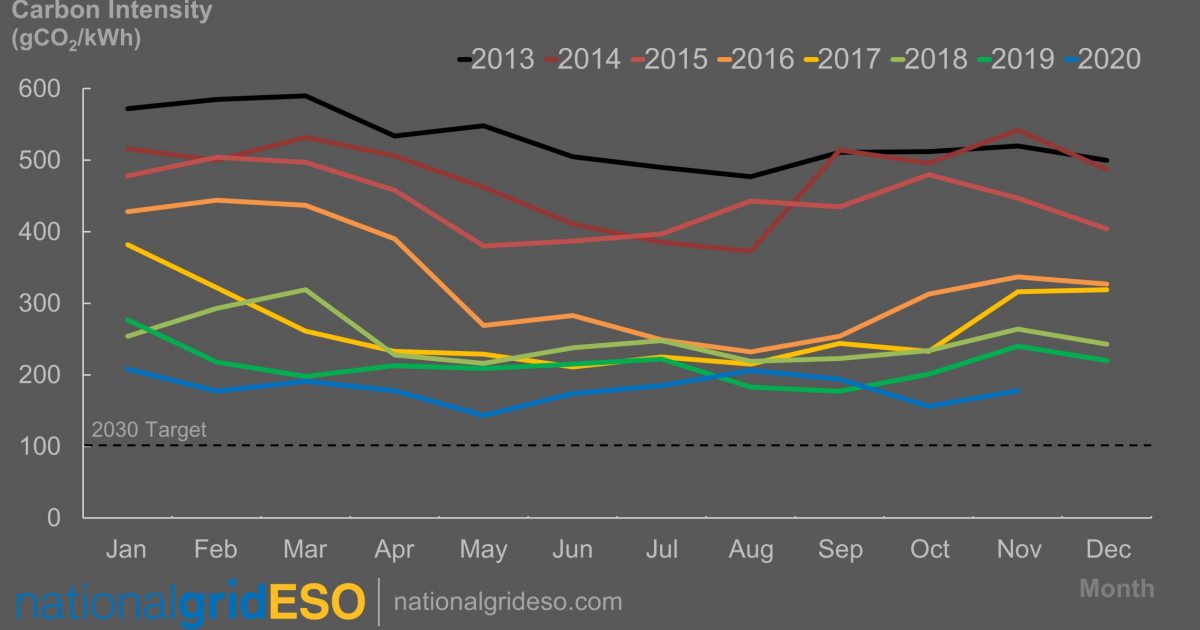The situation is rather dark in Britain at the moment, but among the bright spots is progress on decarbonising its electricity system.
National Grid ESO, the electricity system operator for Great Britain, said yesterday 2020 will be the “greenest” year on record. Wind and solar power set multiple new records this year and average carbon intensity associated with electricity generation reached a new low.
Some of the new records set in 2020 according to National Grid ESO:
- Maximum wind power – 17,278MW on December 18
- Maximum solar power – 9,680MW on April 20
- Longest period without coal power – 1,630 hours (nearly 68 days) on June 16
- Minimum gas-fired generation – 1,531MW on December 26
- Minimum carbon intensity – 46 gCO2/kWh on May 24
Separately, Drax Group reported on December 27 that wind power provided more than 50% of Great Britain’s electricity for the first time on Boxing Day (50.67%).
Electricity Generation Carbon Intensity Plummets
In relation to carbon intensity, here’s how Britain has been tracking since 2013 in terms of grams of carbon dioxide per kilowatt-hour according to National Grid ESO.
- 2013 – 529 gCO2/kWh
- 2014 – 477 gCO2/kWh
- 2015 – 443 gCO2/kWh
- 2016 – 330 gCO2/kWh
- 2017 – 266 gCO2/kWh
- 2018 – 248 gCO2/kWh
- 2019 – 215 gCO2/kWh
- 2020 – ~ 181 gCO2/kWh
.. so, a 59.4% decrease between 2013 and 2019 and assuming the figure for 2020 is pretty spot on, that would be a 63.8% decrease since 2013. The 46 gCO2/kWh record set on May 24 occurred during Britain’s longest coal- free period, which also coincided with the new maximum solar power record.
Just as a comparison, Australia’s power sector emitted 656.4 grams of carbon dioxide per kilowatt-hour of electricity generated in 2020 according to Statista.
On Xmas Day, here’s how Britain’s electricity mix looked:
- Gas: 30.9%
- Wind: 27.1%
- Nuclear: 21.4%
- Imports: 9.1%
- Biomass: 7.0%
- Hydro: 2.9%
- Solar: 1.5%
- Coal: 0.0%
… making Xmas Day Britain’s first without coal power. As for coal perhaps lurking in the 9.1% imports, as far as I’m aware imports are mainly wind and nuclear energy, not the problematic little black (or brown) rock.
It’s of course not a great time of the year for solar power generation in Britain – the University of Sheffield Solar Tracker indicates the peak in the last 4 weeks was on December 1 at 3.91GW – so around 40% of the record. On the day the new solar power record was set, Britain had an estimated 13GW of installed solar capacity and that has barely changed since according to the tracker.
The UK overall has come a long way in ditching its coal power addiction. In 1950, coal power accounted for 97 per cent of all electricity generated and by 2019, that had dropped to just 5% – and it will drop to zero very soon.
The deadline for the phase-out of coal from Britain’s energy system was originally to be 2025, but Prime Minister Boris Johnson announced early this year that date could be brought forward a year to October 1, 2024. A couple of weeks ago, the British Government kicked off a consultation on bringing forward the date.


 RSS - Posts
RSS - Posts



Speak Your Mind